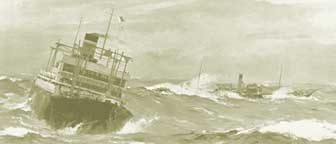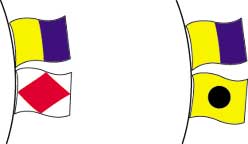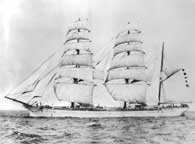
|
|

|
| Flags were probably the
earliest form of communication at sea. National flags have been flown
to identify ships since the 16th century. By the late 18th century,
a system of code flags had been developed, allowing complex messages
to be signaled. Today's international code flag system includes 26 alphabetical
letter flags, ten number pennants and three repeater pennants. Each
letter flag has a meaning when flown individually, or they can be flown
in hoists of two or three flags. Single flag hoists are most often seen
today. While it is possible to spell out whole words with flags, this
is almost never done.
Above: This painting depicts the 1926 rescue of the crew of the British
freighter Antinoe by the U.S. Liner President Roosevelt
during a fierce gale in the North Atlantic. The President Roosevelt
stayed with the Antinoe for 85 hours, flying the code flags
"A" over "I" - "I am standing by to assist."
The crew were finally taken off by lifeboat. Two of the Roosevelt's
seamen died in the rescue attempt. Courtesy S.F. Marine Exchange.
|
 |
| Code flags in use. A drawing by Gordon
Grant shows seamen aboard the ship Star of Alaska, preparing
to raise a flag hoist during a voyage in 1925. |
 |
A Signal and a Reply:
KF -"I require a tug."
KI -"There are no tugs available." |
|

|
| The bark Lord Templetown, under
sail off Cape Flattery, displays her signal letters, KGJP, under her
Canadian ensign from the mizzen. Every vessel had its own four-letter
code. The Lord Templetown was built at Belfast, Northern Ireland,
in 1886 and for many years sailed out of Victoria, B.C. Photo SFMNHP,
J7.20,458n. |
|